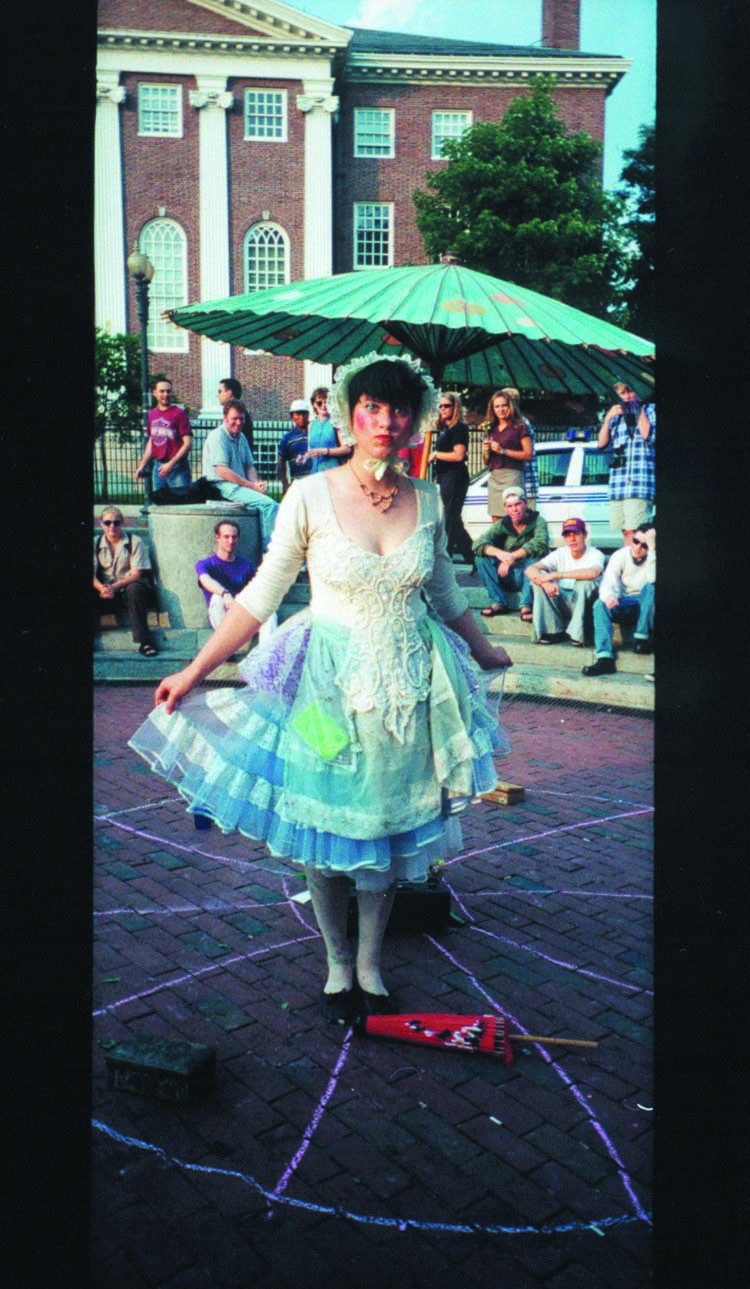
DAY 4! the only existing photos of princess roulette…
this blog was originally posted to patreon. sign up here to read blogs first!
(public post)
hi my friends. the 12 DAYS OF AFP-NESS continues!
first of all, thank you for sharing your selves so candidly in the last post. i’m reading everything and everything is making me feel less alone. i miss that about the internet and this patreon community is making me really happy. facebook is just not the fucking same, especially because it’s impossible to know who a post is going to reach, so i find myself holding back on posting emotional things over there, because i don’t like my emotions going into an algorithm instead of into people.
so, TODAYS THING, day 4….i can’t believe alex unearthed these….
but somewhere deep in a harddrive were these three photographs that i didn’t know existed, or i would have included them in The Art of Asking. (i’m not sure who the photo credit is, i think they came from a fan or an old friend, but they had no credit attached…let me know if you know).
there are TWO MORE PHOTOS from this series up on tumblr, HERE.
(patreon only allows for one photo upload, something they’re working on fixin’, among many other fixy-things).
and since these photos don’t make ANY SENSE without context, here’s some free book!! this is from towards the beginning of “the art of asking”.
and these photos also serve to correct my memory. when i wrote the art of asking, i thought i’d only performed princess roulette in germany. NOT SO. this is in harvard square in around 1999…where i now remember i performed her a handful of times before jettisoning the clunky props for the eight foot bride, who had way less shit to do and way less shit to carry. street performers will understand.
here’s the story.
………..
excerpted from The Art of Asking:
I had dipped my toe into the human statuary experience before, albeit briefly.
While drinking seriously and studying casually during a student exchange in a sleepy little German town called Regensburg, I’d tried out a beta-version of the Eight-Foot Bride: a trippy, white-faced wheel-of- fortune ballerina-statue I named “Princess Roulette.” I stood frozen in the center of a chalk pie- chart I drew in the town square. I’d divided it up into eight sections, each with its own little prop or basket, and I’d wait for a stranger to place a coin in my hat, at which point I’d close my eyes, spin in a circle, and landed with a jerk, pointing at a random space. I’d then mechanically proffer up a small gift (an exotic coin, a candy, an antique key), unless, of course, I’d landed in one of the “suicide” spots, in which case I performed a clownish mini-tragedy in which I mimed killing myself with a variety of prop weapons.
I would spin, stop, open my eyes, trudge slowly over to the waiting bottle of poison while looking incredibly somber, wipe an imaginary tear from my eye, pick up the bottle, drink its invisible contents, and then fall to the cobblestones, gagging and twitching. (I also had a toy gun.) Once I had achieved full corpse pose, I would hope for applause, get up, dust off my glittery tutu, and return to my frozen position in the center.
It was whimsical but grisly, sort of “Harold & Maude” meets Marcel Marceau. The Germans didn’t quite know how to react.
One landing spot was neither gift nor suicide: it was the “tea set,” which was supposed to be the jackpot. If I landed there, I’d grab the hand of my victim, whom I would wordlessly invite to sit on the ground to enjoy an imaginary cup of mime-tea using a vintage collection of cracked cups and saucers. I assumed that this activity would be utterly thrilling to every passerby. I was sorely disappointed by the fact that not every German took me up on my theatrical offer to enjoy a cup of mime-tea. What gave?
It never occurred to me that staging my own comic suicide with different props in the middle of a small town plaza and inviting strangers to sit on the ground probably wasn’t the most effective way to win the hearts and deutschmarks of Bavarian families out on their Sunday strolls.
Princess Roulette quickly taught me a lot about the practicalities and economics of being a living statue/performance artist, and a little bit about Germans. The biggest takeaways:
1 – It is not profitable to give someone a Thing that cost you two deutschmarks if the person you are giving it to only gives you 50 pfennigs.
2 – If you are performing an action in exchange for money, and each action takes two minutes, and obnoxious eight-year-old Bavarian boys are putting 10-pfennig coins in your basket one after the other while people with real money look on with amusement, you are not maximizing your performance time.
3 – Germans wearing nice clothes do not like to sit on the ground.
Although I only performed the Princess Roulette four or five times, I quickly learned that the relationship between a street performer and the street audience is a delicate one, one that adheres to a different contract than the one that exists between the stage performer and the ticket-buying audience. There’s a much greater element of risk and trust on both sides.
I learned this the hard way on my very first day, when a friendly-looking man in his thirties walked by with his toddler daughter. Parents out on walks with their curious children are a godsend to street performers, especially statues; they take great pleasure in supplying their kids with hat- money and watching as their offspring experiences a spontaneous, magical, and yet fully- supervised interaction-with-a-stranger.
This one, however, went a bit pear-shaped. The dad put a deutschmark coin into my hat and I began spinning. As I opened my eyes, I saw that that the little girl had wandered over to one of my roulette-baskets and had helped herself to a huge handful of my gift-candy. Upon seeing this, I was at a loss. This child was stealing my candy. I had never anticipated this problem. After considering, briefly, what the correct action was for my character, I looked the little three-year-old girl straight in the eye and, breaking my mime-silence, pretended to cry. Quietly, but commitedly, I emitted a high-pitched, but measured, anguished whine of agony over the loss of my candy.
This was not the correct thing to do.
The little girl proceeded to burst into ACTUAL tears and let forth her own (far less measured) wail, and for a split second, our collective, pack-like moan of anguish in that little town square in Germany represented some kind of epic, Wagnerian cry of broken, human loss…
WHY?
I stood frozen, in shock, as the horrified father scooped his emotionally assaulted daughter into his arms and flashed me a glare that said, “WHAT HAVE YOU DONE TO MY CHILD?”
I felt really guilty, like I’d scarred this child for life and drained the joy out of future trust-based interactions she may have with any street performers, actors, mimes, or human beings.
I also felt—and this was a new emotion—like a bad artist.
In that moment, something seismic shifted. I’d been viewing my role on the street as a performance artist who would share the gift of her weird artistic theater-wares with the amenable public. I’d grown up an experimental theater kid, writing, directing and acting in my own surreal and morbid plays on school stages. I wasn’t an entertainer—I was making art, dammit. And though I wasn’t afraid to disturb people, I never wanted to hurt them.
This interaction made me realize that working in the street wasn’t like working in “the theater” at all. The Street is Different: nobody’s buying a ticket, nobody’s choosing to be there. On the street, artists succeed or fail by virtue of their raw ability to create a show in unexpected circumstances, to thoroughly entertain an audience that did not expect to be one, and to make people care for a few minutes. The passersby are trusting you to give them something valuable in exchange for their time and attention, and possibly even their dollar. Something skilled, unexpected, delightful, impressive, something moving. With few exceptions, they’re not giving you a dollar to confront and disturb them.
That dad and his little girl didn’t want theater. They didn’t want to be provoked.
They wanted to be entertained.
But they also wanted something more.
They wanted connection.
………..
and back to the blog.
shameless commerce division: if you haven’t read The Art of Asking, you can get the new paperback here (with a new postscript by maria popova from brainpickings) on amazon for only $6 or $7: http://www.amazon.com/The-Art-Ask..
…or be kind to your local indie and look for it here on indiebound: http://www.indiebound.org/book/97..
….OR…hear me gabbing to your ears for 11 straight hours, plus some ukulele n shit, by getting the Art of Asking audiobook, which, sha sha, has won awards:
http://www.audible.com/pd/Self-De..
buy it for everyone for christmas. i worked hard on that sucker.
i love you.
more tomorrow.
x
a
p.s. don’t forget to click through this email (if you’re a patreon and reading this in email form) to comment on site itself. i’m reading.





